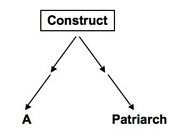
Correction required when using the patriarchal marker values in computing time-to-patriarch
When the patriarchal marker values are employed in a time-to-most-recent-common-ancestor (TMRCA) calculation with a present-day descendant, the result needs to be multiplied by two. Why?
Normally, two individuals, A and B, are related to each other and to the patriarch in this manner:

In this example, there are four generations from either A or B, to the patriarch, and that is the correct TMRCA. But the number of marker differences accumulated between A and B would have resulted from eight birth events -- four in each line. In other words, there are eight generations separating A and B -- eight opportunities for mutation.
When we treat the patriarch as though he were merely another present-day participant, and we compute the number of generations between a present-day descendant and the patriarch, we are in essence putting some mythical third "construct" agent in the picture:

The patriarch is still four generations from A, but the TMRCA calculation will erroneously report two generations (i.e., the number of generations each is from the construct). Thus, when the patriarchal marker values are treated like those of a real, present-day descendant, the result must be multiplied by two to give the correct distance of the patriarch from the real, present-day descendant.